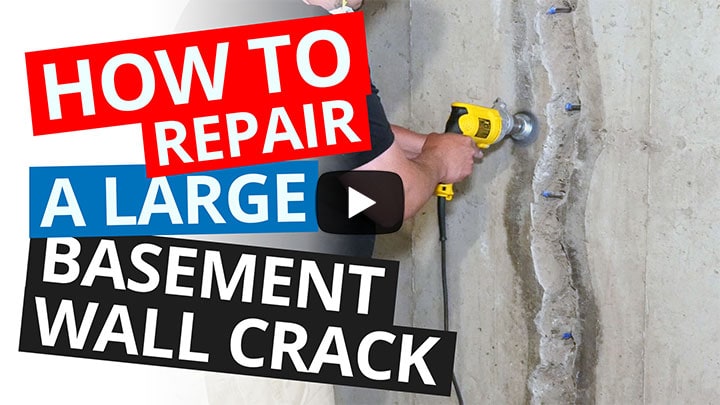How To Repair Basement Walls That Leak
What does it mean when you discover water leaking from a basement wall crack?
The walls exterior of your basement are taking on a tremendous amount of hydrostatic force per unit area. That pressure is a buildup of groundwater around and outside your basement walls, as well known as the false h2o table. The walls will subtly push inward and produce a cleft.

Somewhen, the fissure volition widen some more to the point of producing an entrance to the outside. Groundwater volition detect its manner through the fissure, run downward the wall and onto your floor. Your foundation's integrity is at present compromised; simply a worse scenario can follow the first intrusive crack.
How to fix a basement wall scissure?
- Chisel out moist deteriorated concrete from the crevice.
- Clean the area around the crack to remove dust and debris.
- Drill holes every pes inside the length of the crack.
- Insert grease fittings/pins into holes.
- Tighten grease fittings/pins in holes with a ratchet tool. A gasket on the grease plumbing equipment will expand and stay in identify.
- Screw on a grease-plumbing fixtures tip onto the pivot.
- Utilise a slurry-similar cement around the pins without roofing the tips.
- Fill grease gun with a hydro-active gel (epoxy).
- Attach grease gun hose to grease fitting tip.
- Slowly squeeze the hydro-active gel (epoxy) into the grease fitting tip until you see some gel dripping out, then stop.
- Repeat step 10 with the rest of the grease-fitting pins. The gel volition push through and spread forth the scissure to the outside.
- Fill the rest of the crevice with slurry. Comprehend the pins with slurry and trowel a smooth surface.
Spotter the following video to see how a wall fissure is properly repaired.

Can I prevent any more cracks from forming on my basement walls?
Yes. We now know that hydrostatic pressure is the reason why water was seeping through a wall fissure. If we don't stop the force per unit area, a crack can grade on another wall in the basement. It is essential to reduce the hydrostatic pressure level by installing a drainage system to manage the h2o and redirect it away from the business firm.
How do y'all manage water to prevent basement wall cracks?
You tin accept an exterior or interior drainage system installed to aid redirect water away from your house. Both installations are labor-intensive, but an exterior drainage system requires a lengthier timetable, higher cost, intrusive, and not durable. Most outside installations give a ten-year warranty. Why? Because they are "not durable."
An exterior system tin can suffer from slit clogging, root intrusion, the ebb and flow of soft pan clay, or turn into a rodent superhighway. The new waterproofing membrane will erode in 3 to 5 years, just similar the one practical during the business firm'southward construction.
American Dry out Basement Systems can install an interior basement waterproofing system in ane to 3 days, depending on foursquare footage. The installation comes in at a lower toll and a life-fourth dimension warranty/guarantee. You can have the confidence to finish information technology or utilise it to store your items.
What else should you expect out for besides basement wall cracks?
Probable, h2o is also entering the basement from where the floor meets the wall. Its also known as the "cove." Hydrostatic pressure pushes groundwater through the cove because it is a cold joint. Common cold joints are made by pouring wet concrete into molds on top of the dry slab (concrete floor). They never really get a chance to demark together.

That "cove" is similar to a crevice. In that location is no perfect seal between the wall and flooring. In 3 to v-years, the waterproof membrane on the exterior wall wears away. The cove will no longer be a shield against the groundwater from entering.
Moisture physical forth cold joints is a visual indicator that groundwater could be entering your basement. Some other visual indicator, perhaps not as threatening, is the presence of white glittering powder on your cement walls chosen efflorescences. This white powdery substance is the event of exposure to acidic groundwater — the acidic nature of water leeches the lime in cement walls. You might be experiencing a leaky wet basement right now, or you will find it in the hereafter when you see efflorescences.
The chances are high that h2o is entering your basement through the cove if you have a leaking basement wall crevice. It is imperative to go both problems resolved simultaneously to eliminate any chance of information technology happening again.
Learn More! Get more data about safeguarding your basement from water seepage by reading our other post: FLOODING DUE TO MELTING Snow.
Phone call 888-748-2002 to schedule a costless appointment with American Dry Basement Systems today!

What are Basement Engineering science Tabs?
Basements should have engineering science tabs fabricated during basement waterproofing for a strong foundation. Leaving sections of your floor on the footer is vital.

Wet Basement Problem: Fake Water Table
A false water table is the primary cause of wet basements, deteriorating foundation walls, and cracking floors. Information technology is "simulated" considering information technology is temporary.

6 Ways to Forbid Basement Flooding
Basement flooding unremarkably occurs when groundwater finds the path of least resistance. There are vi things you lot can practise to forestall flooding inside your basement.

What is a Monolithic Slab Foundation?
A monolithic slab foundation is created past pouring a unmarried layer of concrete to grade a slab and basis. The structure procedure is faster and low cost.
Useful guide: General Let for the Discharge of Stormwater
Source: https://americandry.com/fixing-a-leaking-basement-wall-crack/
Posted by: bernaltheref.blogspot.com


0 Response to "How To Repair Basement Walls That Leak"
Post a Comment